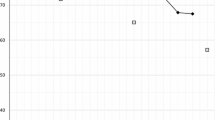Abstract
In this paper we develop and test a model of voter turnoutthat permits us to differentiate turnout rates for governmentemployees and other citizens, controlling for the effects of awide range of other variables relating to turnout. Using 1996ANES data, we find that there is a significant difference inturnout rates for bureaucrats and nonbureaucrats, both insimple bivariate analyses and in a full multivariate model.The magnitude and significance of the coefficient forgovernment employment, even in the face of controls, suggeststhere is something about government employment per sethat has an effect on turnout.
Similar content being viewed by others
References
Aldrich, J. (1995). Why parties?: The origin and transformation of party politics in America. Chicago: University of Chicago Press.
Bennett, J.T. and Orzechowski, W.O. (1983). The voting behavior of bureaucrats: Some empirical evidence. Public Choice 41: 271–283.
Blair, W. and Garand, J. (1995). Are bureaucrats different?: Democratic values, political tolerance, and support for the political system among government employees and other citizens, 1982-1992. Presented at the annual meetings of the American Political Science Association, Chicago, IL.
Blair, W. and Garand, J.C. (1997). Bureaucratic constituency influence on congressional roll-call behavior: The influence of government employees on congressional support for spending. Presented at the annual meeting of the American Political Science Association, Washington, DC.
Blais, A. and Dion, S. (Eds.). (1991). The budget-maximizing bureaucrat: Appraisals and evidence. Pittsburgh: University of Pittsburgh Press.
Blais, A., Blake, D.E. and Dion, S. (1990). The public/private sector cleavage in North America. Comparative Political Studies 23: 381–403.
Blais, A., Blake, D.E. and Dion, S. (1997). Government, parties, and public sector employees. Pittsburgh: University of Pittsburgh Press.
Blake, D.E. (1991). Policy attitudes and political ideology. In A. Blais and S. Dion (Eds.), The budget-maximizing bureaucrat: Appraisals and evidence. Pittsburgh: University of Pittsburgh Press.
Borcherding, T.E., Bush, W.C. and Spann, R.M. (1977). The effects on public spending of the divisibility of public outputs in consumption, bureaucratic power, and the size of the tax-sharing group. In T.E. Borcherding (Ed.), Budgets and bureaucrats: The sources of government growth. Durham, NC: Duke University Press.
Brehm, J. and Rahn, W. (1997). Individual-level evidence for the causes and consequences of social capital. American Journal of Political Science 41: 999–1023.
Burden, B. (1999). Measuring voter turnout in the national election studies. Paper presented at the annual meeting of the American Political Science Association, Atlanta, Georgia.
Bush, W.C. and Denzau, A.T. (1977). The voting behavior of bureaucrats and public sector growth. In T.E. Borcherding (Ed.), Budgets and bureaucrats: The sources of government growth. Durham, NC: Duke University Press.
Downs, A. (1957). An economic theory of democracy. New York: Harper.
Frey, B.S. and Pommerehne, W.W. (1982). How powerful are public bureaucrats as voters? Public Choice 38: 253–262.
Garand, J., Parkhurst, C. and Seoud, R. (1991). Bureaucrats, policy attitudes, and political behavior: Extension of the bureau voting model of government growth. Journal of Public Administration Research and Theory 1: 177–212.
Gilens, M. (1999). Why Americans hate welfare: Race, media, and the politics of antipoverty policy. Chicago: University of Chicago Press.
Gramlich, E.M. and Rubinfeld, D.C. (1982). Voting on public spending: Differences between public employees, transfer recipients, and private workers. Journal of Policy Analysis and Management 1: 516–533.
Jacoby, W. (1994). Public attitudes toward government spending. American Journal of Political Science 38: 336–361.
Lewis, G. (1990). In search of the Machiavellian milquetoasts: Comparing attitudes of bureaucrats and ordinary people. Public Administration Review 50: 220–227.
Niskanen,W. (1971). Bureaucracy and representative government. Chicago: Aldine Atherton, Inc.
Niskanen, W. (1991). A reflection on bureaucracy and representative government. In A. Blais and S. Dion (Eds.), Budget-maximizing bureaucrat: Appraisals and evidence. Pittsburgh: University of Pittsburgh Press.
Rosenstone, S. and Hansen, J.M. (1993). Mobilization, participation and democracy in America. New York: Macmillan.
Squire, P., Wolfinger, R. and Glass, D. (1987). Residential mobility and voter turnout. American Political Science Review 81: 45–65.
Timpone, R.J. (1998). Structure, behavior, and voter turnout in the United States. American Political Science Review 92: 145–158.
Wood, B.D. (1988). Principals, bureaucrats, and responsiveness in Clean Air Enforcements. American Political Science Review 82: 213–234.
Wood, B.D. and Waterman, R.W. (1991). The dynamics of political control of the bureaucracy. American Political Science Review 85: 801–828.
Wolfinger, R. and Rosenstone, S. (1980). Who votes? New Haven: Yale University Press.
Author information
Authors and Affiliations
Rights and permissions
About this article
Cite this article
Corey, E.C., Garand, J.C. Are Government Employees more Likely to Vote?: An Analysis of Turnout in the 1996 U.S. National Election. Public Choice 111, 259–283 (2002). https://doi.org/10.1023/A:1015290806607
Issue Date:
DOI: https://doi.org/10.1023/A:1015290806607




